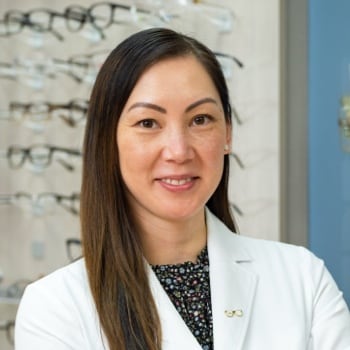Driving requires an all-hands-on-deck approach. Staying responsive to your surroundings is paramount no matter the road conditions, but when visibility seems weaker, it poses a hazard to your safety.
Nighttime equals low-light conditions. Your eye can accommodate changing brightness levels but cannot multitask as it encounters bright oncoming headlights, traffic lights, and other obstacles.
Yellow-tinted night driving glasses are becoming popular, as they claim to improve night driving conditions. However, they aren’t very effective and can actually pose a risk to your safety.
Meanwhile, anti-reflective (or anti-glare) lens coatings improve visual clarity by reducing excess light scatter, which causes glare. They’re helpful for anyone needing extra support when night driving, whether you require prescription glasses or not.
Sometimes, difficulty night driving may indicate an underlying concern, which routine eye exams can detect. With timely intervention and discussing your options with your optometrist, we can find the right tools to support your vision when night driving, helping to keep you safe.
How Eyes Adjust in Low Light
Your body’s ability to adapt to its surrounding environment is incredible. When you find yourself in dimly lit spaces, several key changes occur within the eye, reflecting the environment.
Your pupils expand, allowing more to enter the eye when brightness is lacking. Think of this as your eyes “opening up” to gather light, like a camera lens.
Inside the retina, your rod cells take center stage. Unlike their cone counterparts, which perform better in bright light, rods cannot perceive color or sharp details but are very sensitive to low-light conditions.
Therefore, when driving at night, overall visibility is already slightly off. As your eye adjusts to low-light conditions, glare from streetlights, headlights, or reflective surfaces often creates further visual discomfort. Although your pupils dilate to accommodate this change, they can’t filter out harsh light from surrounding traffic.
High beams or misaligned headlights scatter incoming light, creating glare that reduces contrast and makes everything appear hazy. For those with eye conditions like astigmatism or cataracts, this glare can further blur and distort vision.
How Aging Affects Visual Clarity
As we grow older, changes occur within the eye–like other areas in the body–making it more difficult to see in certain conditions.
So, if you’ve noticed night driving feels more challenging than before, you’re not alone. This can happen for several reasons, making night driving feel unsafe:
- Decreased pupil response: The pupils become less responsive to changes in light. They take longer to adjust when transitioning from bright to dark environments.
- Yellowing of the lens: Your eye’s lens may gradually tint yellow, reducing the amount of light reaching your retina, and further decreasing low-light vision clarity and contrast sensitivity.
- Cataracts: A cataract develops naturally with age, clouding the eye’s natural lens. This causes incoming light to scatter, leading to glare and halos around bright lights; two of the common night driving struggles.

Night Driving: The Risks
If driving in ideal conditions can pose a risk to your safety, then less visual clarity when night driving can also pose significant dangers.
Studies show that traffic accidents are three times more likely to occur at night than during the day, even though typically fewer cars are on the road because of visual impairment.
Common challenges that impaired night vision can create include:
- Struggling to gauge the speed or distance of oncoming traffic.
- Difficulty spotting pedestrians or cyclists on poorly lit roads.
- Increased reaction time because of reduced depth perception.
A combination of poor visibility and higher risk means addressing these challenges is crucial, through glasses or simply scheduling regular eye exams. Taking these steps can make a big difference for your safety and confidence on the road.
All About Eyeglasses for Night Driving
The good news is that you can support your vision and comfort when night driving with the right glasses.
If you’re experiencing certain symptoms, like frequent glare, trouble adjusting to low light, or overall reduced clarity while driving at night, it’s time to visit your optometrist. An eye exam can determine if an underlying eye condition is the culprit, or whether updated prescription glasses with the right lens coating, like anti-reflection, are the right solution.
There are two common choices when it comes to improving visual clarity while night driving:
- Anti-reflective (or anti-glare) glasses
- Yellow-tinted night driving glasses
Anti-reflective Lens Coating
These glasses have a lens coating that reduces excess light scatter, resulting in less glare and halos from oncoming reflective surfaces. This improves contrast and overall visual clarity when night driving.
Anti-reflective glasses are a safe and effective option for almost anyone bothered by glare, whether you wear prescription glasses or not!
Night Driving Glasses
These yellow-tinted glasses–which claim to improve contrast and reduce glare–are becoming popular among drivers. Although these can slightly improve the appearance of contrast in certain lighting conditions, they also reduce the total amount of light entering your eye, posing a hazard when night driving.
Research shows yellow-tinted glasses don’t significantly improve night vision and can actually worsen overall visibility in darker environments. For this reason, they are not recommended as a safer alternative to anti reflective glasses.
Unlike their yellow-tinted counterpart, anti-reflective glasses address glare without compromising overall visibility. This makes them far better for night driving because they improve comfort and support vision without introducing new risks.
Better Vision Starts with Regular Eye Exams
If night driving has become a stressful or uncomfortable experience, putting up with it shouldn’t be an option. An eye exam can help identify if you need glasses, or if there are underlying conditions like cataracts that may require additional care.
Your optometrist is your partner in achieving clearer, safer vision, guiding you toward a solution tailored to your visual needs! Connect with our Eyes on Plainville team to schedule your routine eye exam or browse our unique selection of frames.





